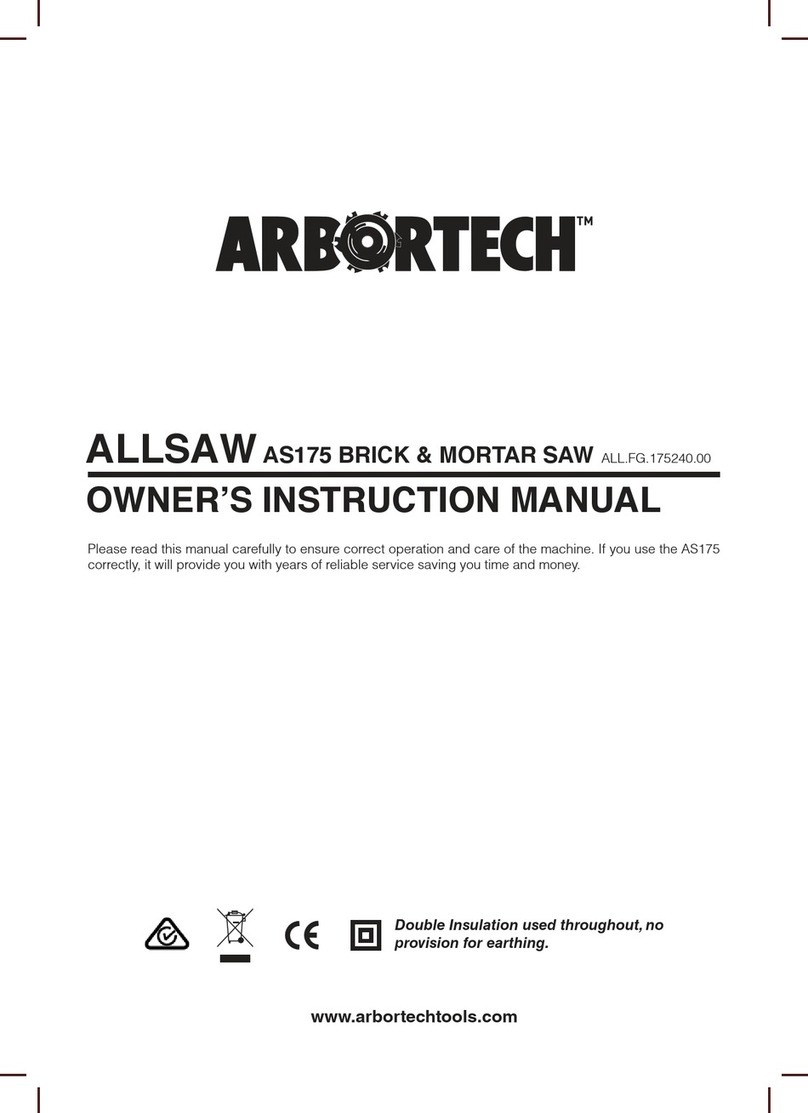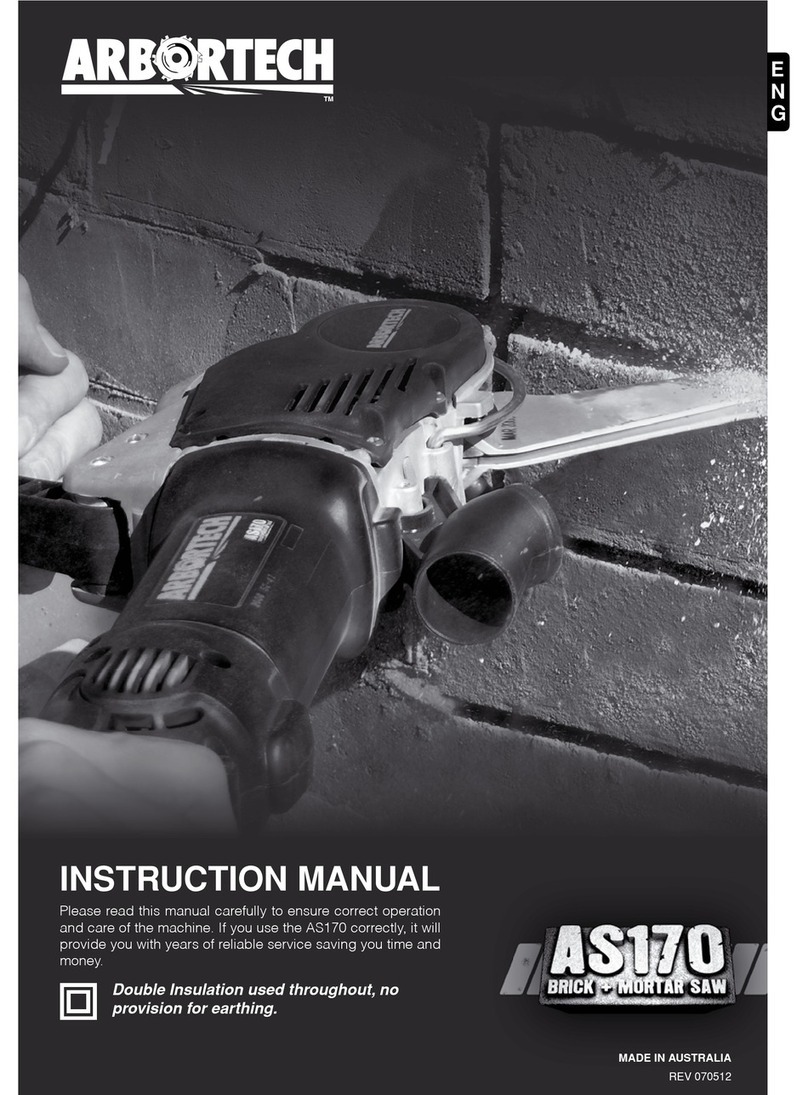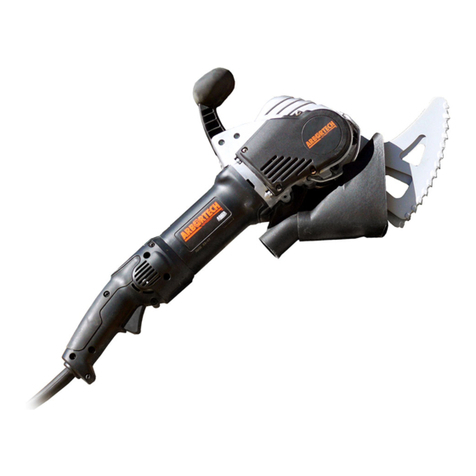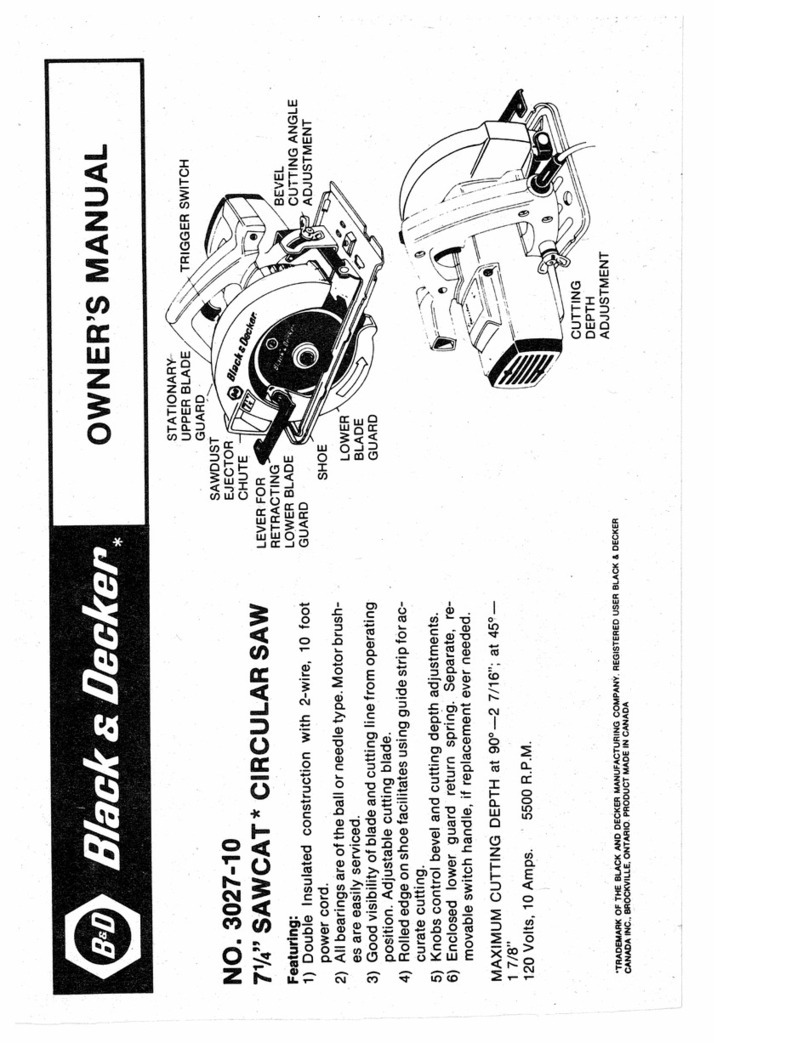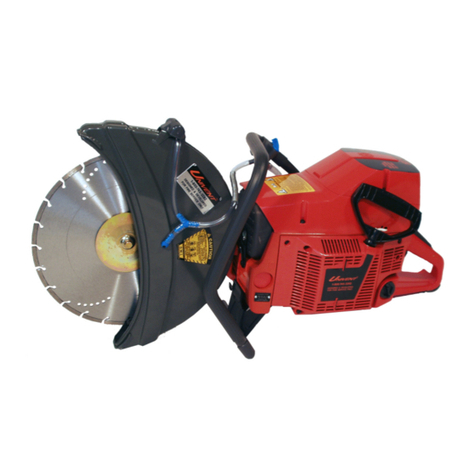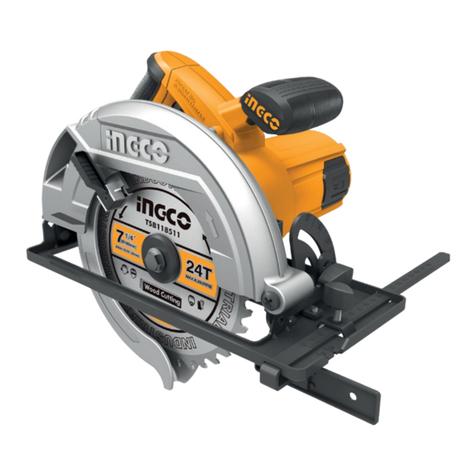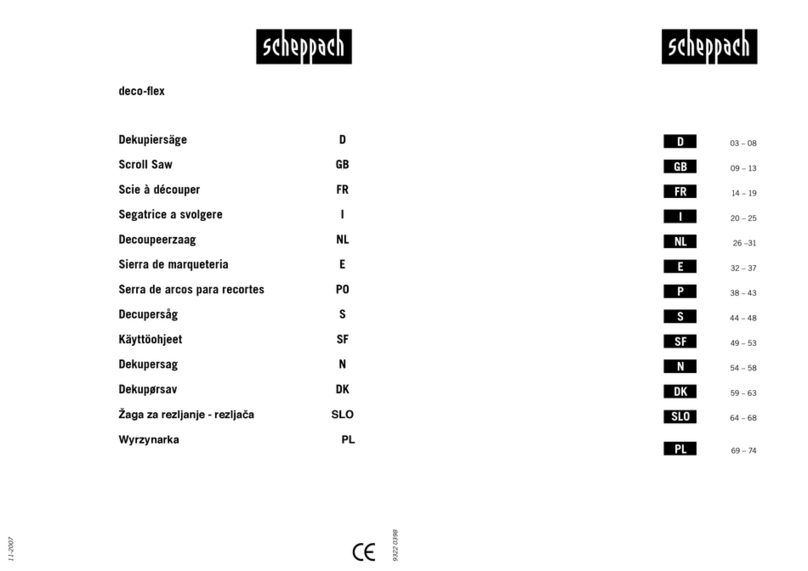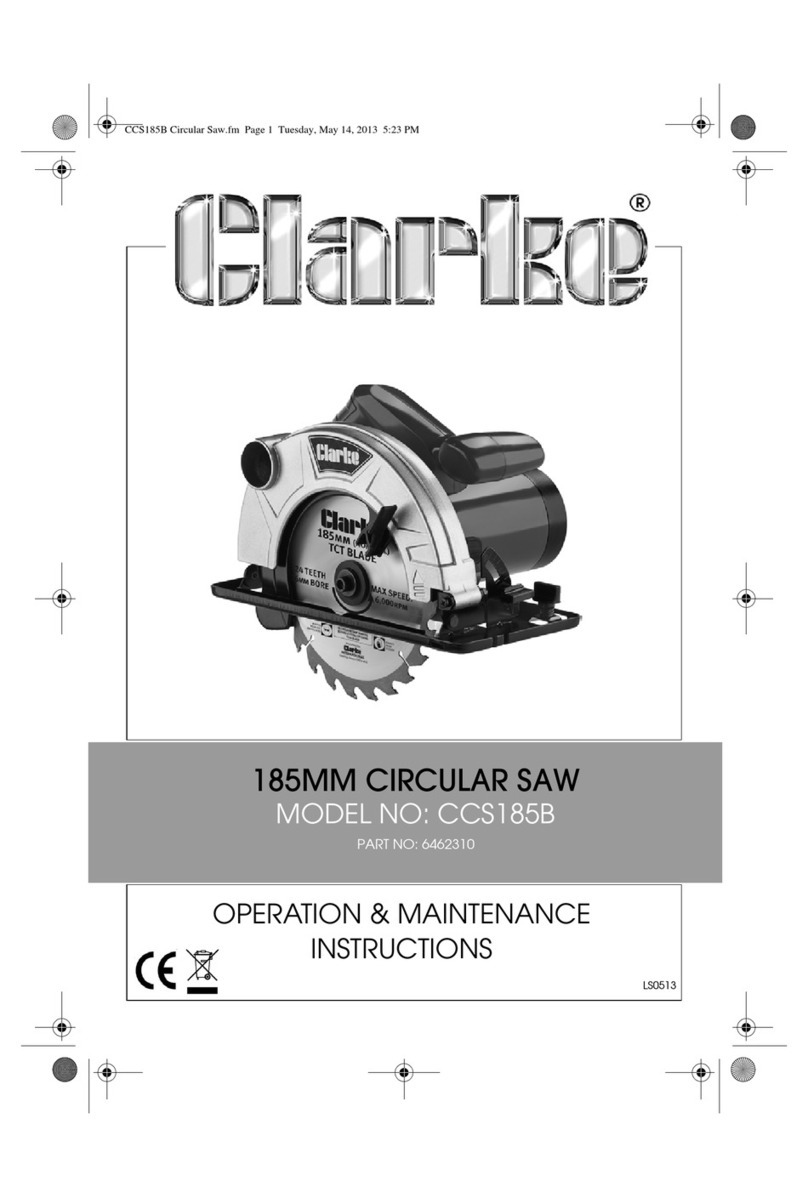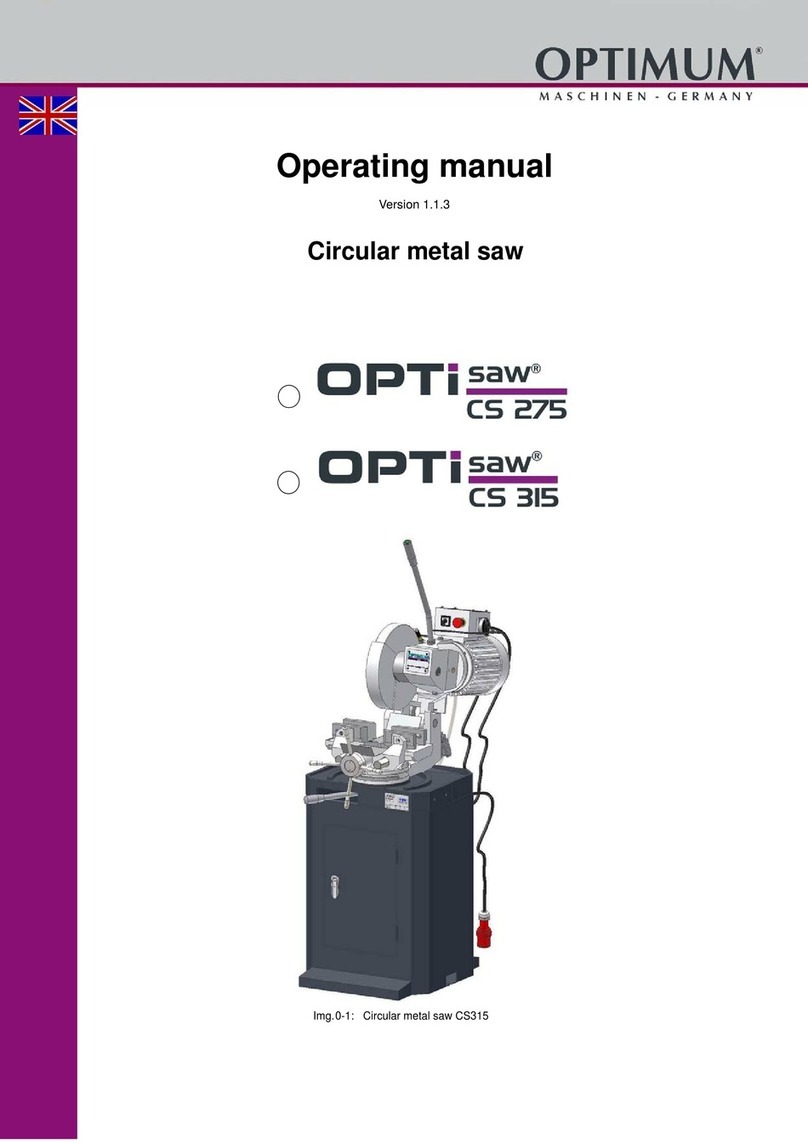
1. INTRODUCTION
The Arbortech AS200X Brick & Mortar Saw is
designed and manufactured in Australia, using only
the highest quality components and manufacturing
processes.
The unique patented orbital cutting action of two
reciprocating blades, allows cutting of brick, mortar
and masonry faster than traditional reciprocating
saws.
This cutting action also produces minimal amounts
of airborne dust, offering a safe and controllable
operation, with the ability to cut to a depth of
120mm (4 3/4”), cut square corners and make
variable width cuts. The AS200X is ideally suited to
a variety of tasks including:
•removal of mortar for tuck pointing of brick
walls
•removal of single bricks from walls
•cutting of bricks without damage to adjacent
areas or “blow-out” stitching, keying or toothing
of brick walls “chasing” cuts for conduits and
similar items into walls
•cutting holes in walls or other surfaces
•finishing corner cuts in walls.
The tool can be fitted with a range of blades to best suit
different applications.
Definitions: Safety Guidelines
The definitions below describe the level of severity
for each signal word. Please read the manual and
pay attention to these symbols.
DANGER: Indicates an imminently hazardous
situation which, if not avoided, will result in death
or serious injury.
WARNING: Indicates a potentially hazardous
situation which, if not avoided, could result in
death or serious injury.
CAUTION: Indicates a potentially hazardous
situation which, if not avoided, may result in minor
or moderate injury.
CAUTION: Used without the safety alert symbol
indicates a potentially hazardous situation which, if not
avoided, may result in property damage.
Denotes risk of electric shock.
2. GENERAL POWER TOOL
SAFETY WARNINGS
WARNING Read all safety warnings,
instructions, illustrations and specifications
provided with this power tool. Failure to follow all
instructions listed below may result in electric shock,
fire and/or serious injury.
Save all warnings and instructions for future
reference.
The term "power tool" in the warnings refers to your
mains-operated (corded) power tool.
1)
Work area safety
a)
Keep work area clean and well lit. Cluttered and
dark areas invite accidents.
b)
Do not operate power tools in explosive
atmospheres, such as in the presence of
flammable liquids, gases or dust. Power tools
create sparks which may ignite the dust or fumes.
c)
Keep children and bystanders away while
operating a power tool. Distractions can cause you
to lose control.
2)
Electrical safety
a)
Power tool plugs must match the outlet. Never
modify the plug in any way. Do not use any
adapter plugs with earthed (grounded) power
tools. Unmodified plugs and matching outlets will
reduce risk of electric shock.
b)
Avoid body contact with earthed or grounded
surfaces such as pipes, radiators, ranges and
refrigerators. There is an increased risk of
electric shock if your body is earthed or grounded.
c)
Do not expose power tools to rain or wet
conditions. Water entering a power tool will
increase the risk of electric shock.
d)
Do not abuse the cord. Never use the cord for
carrying, pulling or unplugging the power tool.
Keep cord away from heat, oil, sharp edges or
moving parts. Damaged or entangled cords
increase the risk of electric shock.
e)
When operating a power tool outdoors, use an
extension cord suitable for outdoor use. Use of
a cord suitable for outdoor use reduces the risk of
electric shock.
f)
If operating a power tool in a damp location is
unavoidable, use a residual current device
(RCD) protected supply. Use of an RCD reduces
the risk of electric shock.
3)
Personal safety
a)
Stay alert, watch what you are doing and use
common sense when operating a power tool.
Do not use a power tool while you are tired or
under the influence of drugs, alcohol or
medication. A moment of inattention while
operating power tools may result in serious
personal injury.
b)
Use personal protective equipment. Always
wear eye protection. Protective equipment such
as a dust mask, non-skid safety shoes, hard hat or
hearing protection used for appropriate conditions
will reduce personal injuries.
c)
Prevent unintentional starting. Ensure the
switch is in the off-position before connecting
to power source and or battery pack, picking up
or carrying the tool. Carrying power tools with
your finger on the switch or energising power tools
that have the switch on invites accidents.
d)
Remove any adjusting key or wrench before
turning the power tool on. A wrench or a key left
attached to a rotating part of the power tool may
result in personal injury.
e)
Do not overreach. Keep proper footing and
balance at all times. This enables better control of
the power tool in unexpected situations.
f)
Dress properly. Do not wear loose clothing or
jewellery. Keep your hair, clothing and gloves
away from moving parts. Loose clothes, jewellery
or long hair can be caught in moving parts.
g)
If devices are provided for the connection of
dust extraction and collection facilities, ensure
these are connected and properly used. Use of
these devices can reduce dust-related hazards.
h)
Do not let familiarity gained from frequent use
of tools allow you to become complacent and
ignore tool safety. A careless action can cause
severe injuries within a fraction of a second.
4)
Power tool use and care
a)
Do not force the power tool. Use the correct
power tool for your application. The correct
power tool will do the job better and safer at the
rate for which it was designed.
b)
Do not use the power tool if the switch does
not turn it on and off. Any power tool that
cannot be controlled with the switch is
dangerous and must be repaired.
c)
Disconnect the plug from the power source
and/ or the battery pack from the power tool
before making any adjustments, changing
accessories, or storing power tools. Such
preventive safety measures reduce the risk of
starting the power tool accidentally.
d)
Store idle power tools out of the reach of
children and do not allow persons unfamiliar
with the power tool or these instructions to
operate the power tool. Power tools are
dangerous in the hands of untrained users.
e)
Maintain power tools and accessories. Check
for misalignment or binding of moving parts,
breakage of parts and any other condition that
may affect the power tools operation. If
damaged, have the power tool repaired before
use. Many accidents are caused by poorly
maintained power tools.
f)
Keep cutting tools sharp and clean. Properly
maintained cutting tools with sharp cutting edges
are less likely to bind and are easier to control.
g)
Use the power tool, accessories and tool bits
etc. in accordance with these instructions,
taking into account the working conditions
and the work to be performed. Use of the power
tool for operations different from those intended
could result in a hazardous situation.
h)
Keep handles and grasping surfaces dry, clean
and free from oil and grease. Slippery handles
and grasping surfaces do not allow for safe
handling and control of the tool in unexpected
situations.
5)
Service
a)
Have your power tool serviced by a qualified
repair person using only identical replacement
parts. This will ensure that the safety of the power
tool is maintained.
6)
Safety instructions for reciprocating
saws
a)
Hold the power tool by insulated gripping
surfaces, when performing an operation where
the cutting accessory may contact hidden
wiring or its own cord. Cutting accessory
contacting a "live" wire may make exposed metal
parts of the power tool "live"and could give the
operator an electric shock.
b)
Use clamps or another practical way to secure


